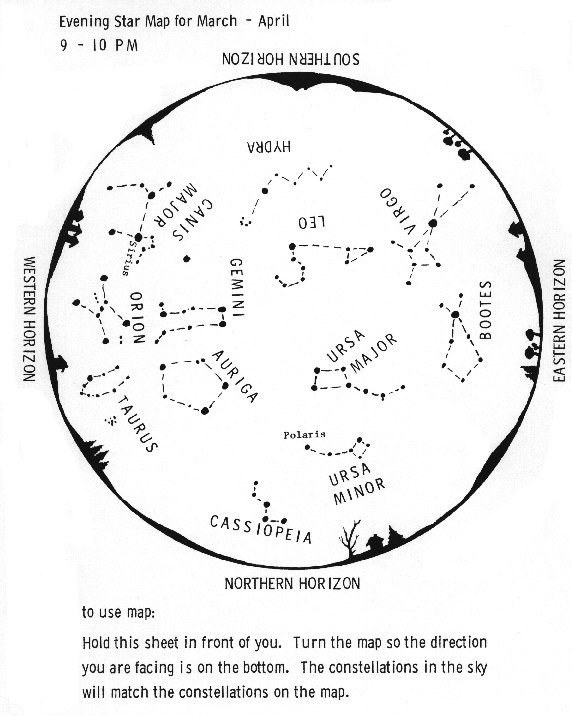Finding Things in the Sky

Finding Things in the Sky
Purpose
The student will explore coordinate systems and ways to find things in the sky.
Materials
Paper and pencil
Planetarium
Background and Theory
The very first problem in astronomy is to get everyone talking about the same thing. This is much harder than in many other sciences. For example, in biology, you can say 'This big ugly frog here, the one with the blue and white speckles on its back, is poisonous.', and hand it to your colleague, whom you presumably hate. In astronomy, however, you can say 'That dot there. The reddish one. No. THAT one. What's the matter with you?! Come on, it's right there!' See? Much harder. Astronomers have invented all sorts of ways to make sure that our colleagues know what we are talking about. You will play with these methods in this lab.
Procedure
Print out the worksheet.
Part A: Building the Map:
- This part of the lab will be done in groups of two. Get together with your neighbor. Introduce yourselves. Now, each of you pick a star in the planetarium sky. Any star will do, but they should not be the same star! Use the 'pointing and yelling' method of stellar identification to get your neighbor to look at the same star.
- Now, on a separate sheet of paper, draw a 'constellation' with that star in it. Draw several (at least 10) stars around the star in question. Make these stars larger on your picture if they are brighter, and try to get the separations right. Draw an arrow that points to your chosen star.
- Exchange maps with your partner. Examine their map carefully. Does it accurately represent the sky around their star? Can you find their star from their map? If not, help them make corrections to the map, and give them their paper back.
Part B: Finding the Coordinates: Altitude and Azimuth
- Your fist at arm's length spans about 10 degrees on the sky. Your outstretched hand is about 20 degrees, and the tip of your index finger is about one degree on the sky. Using these crude measurements, you can find the altitude of your star (its height above the horizon). Do that now, and write it down on the worksheet.
- Around the 'cove' of the planetarium, there are markers telling the direction: north, south, east and west, along with the azimuthal angle. These four basic points have been further subdivided. Estimate the azimuth of your star, and write it on the worksheet.
Part C: Finding the Coordinates: Right Ascension and Declination
- Now your instructor will add the celestial coordinate system to the sky. Find the R.A. and Dec of your star, and write them on the worksheet.
Part D: Stump the Chumps
- Get together with another pair of students. Get the altitude and azimuth coordinates of a star from another student (you will exchange coordinates three times---I don't care how you do it, but for each of these times, you should get a different star to look for).
- Look at the altitude and azimuth coordinates of the star. Find the star in the sky, and draw a map of the location of that star in the sky. As in Part A, include at least 10 stars, and make them larger when they are brighter. Use an arrow to show which star you think was indicated by the altitude and azimuth given. Label the bottom of your chart with the words 'Alt/Az', and the altitude and azimuth of the star in question. Give this piece of paper to the student who gave you the coordinates.
- Now get a Right Ascension and Declination from another student. Use the right ascension and declination to locate the star in the sky, and draw the star map, labeling it with 'RA and Dec', and the coordinates of the star in question. Give your map to the student who gave you the coordinates.
- Finally, wait for your instructor to change the date or time of your observations. Now choose which coordinate system to use, and ask the third student to give you those coordinates for the star in the sky. Again, draw a star map indicating the location of the star in the sky. Write the name of the coordinate system you've used under the map you've drawn, and the coordinates you were given. Give this map to the student who gave you the coordinates.
Part E: Who's the Chump?
- Now, you should have four star maps for the same star. Compare them. Are they similar? Did the other students in the class identify 'your' star correctly? How could you have helped them do better? (Include all four maps when you hand in your work.)
- In general, what's the best method for getting people (who are just observing for fun) to find things in the sky (pointing, constellations (or star maps), horizon coordinates or celestial coordinates)?
- Is this the best method for professional astronomers? Why or why not?
© 2003 Weber State University
Revised: 24 April, 2003
